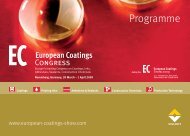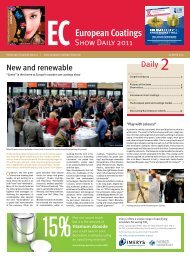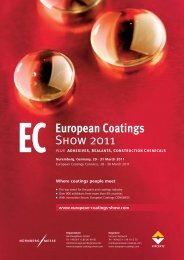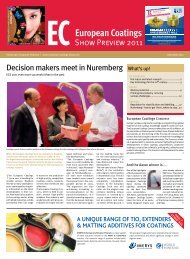Download EC SHOW DAILY 2013 Issue No. 1 - European Coatings ...
Download EC SHOW DAILY 2013 Issue No. 1 - European Coatings ...
Download EC SHOW DAILY 2013 Issue No. 1 - European Coatings ...
Create successful ePaper yourself
Turn your PDF publications into a flip-book with our unique Google optimized e-Paper software.
<strong>European</strong> <strong>Coatings</strong> Show Daily 1 19 March <strong>2013</strong> www.european-coatings-show.com<br />
Starting with applications like<br />
TV-housings, sports goods,<br />
automotive rear spoilers and<br />
buttons in the 60s and 70s of<br />
the 20th century, the coating<br />
of plastics, after getting over<br />
some early design challenges,<br />
has developed into an innovative<br />
technology. In particular<br />
the finishing and decoration<br />
of plastic surfaces has become<br />
a large industry. A guiding<br />
effect to today's industry<br />
came from the evolution of<br />
automotive manufacturing.<br />
Important milestons of development<br />
were the initial design<br />
of performance plastic resins,<br />
followed by advances in injection<br />
moulding processes and<br />
tool design.<br />
The technical properties of industrially<br />
coated plastics are<br />
investigated with specified<br />
test methods and compared<br />
with the demands of specifications.<br />
The latter depend on the<br />
kind of object to be coated,<br />
whether it represents an in-<br />
Additives are substances<br />
which are added to a coating<br />
composition in small<br />
amounts, commonly less<br />
than one percent to alter the<br />
properties of a liquid paint or<br />
the reultant solid coating in a<br />
particular direction.<br />
The book “Understanding<br />
additives” by Bodo Müller<br />
provides a description of the<br />
chemistry and applications<br />
technology behind various<br />
paint additives.<br />
It is devided in the chapters<br />
for wetting and dispersing<br />
agents, substrate-wetting additives<br />
and levelling agents,<br />
defoamers, rheologically active<br />
additives, catalysts, adhesion<br />
promoters, corrosion<br />
protection additves, protec-<br />
<strong>Coatings</strong> for Plastics<br />
Guido Wilke,<br />
Jürgen Ortmeier<br />
cection-moulded part or for instance<br />
an extruded foil or plate.<br />
The book “<strong>Coatings</strong> for<br />
Plastics” presents the technology<br />
of coating plastics in a<br />
broad and integrated mode,<br />
treating both the single influence<br />
fields and their connections.<br />
The authors Guido Wilke<br />
and Jürgen Ortmeier set one<br />
focus on the plastic substrate<br />
itself, as it is the origin of many<br />
characteristic issues. Substrate<br />
topics are then connected<br />
with coating relevant plastic<br />
processing aspects and surface<br />
pre-treatment methods.<br />
The chapter of coating materials<br />
presents a broad portfolio<br />
of modern formulation and<br />
layer concepts, their main characteristics<br />
with respect to end<br />
users requirements.<br />
This highly topical book offers<br />
in-depth knowledge and a multitude<br />
of practical tips, e.g. for<br />
safeguarding the quality of the<br />
coating film, and for developing<br />
high-performance coatings for<br />
plastics. The main emphasis<br />
is on the properties of plastics<br />
and the materials used to coat<br />
them. A special feature of the<br />
book is a separate chapter devoted<br />
to the topics of typical<br />
coating flaws, analytical and<br />
test methods and precautionary<br />
measures. xz<br />
Understanding<br />
Additives<br />
Bodo Müller<br />
tion of coatings from weathering,<br />
photoinitiators and coalescing<br />
agents.<br />
It covers everything about<br />
the mode of action, application<br />
and possible side effects<br />
of the most improtan coatings<br />
additives. Thus enabling<br />
readers to rapidly gain a solid<br />
grounding in thes critical, yet<br />
compley constituents of all<br />
paint formulations. The book<br />
provides an overview and indepth<br />
basic knowledge of the<br />
most improtant classes of additives.<br />
The various types of<br />
damage eliminated or prevented<br />
by additives are vividly<br />
illustrated with colour photos.<br />
Practitioners will further<br />
welcome the guide formulations<br />
for explaining how the<br />
additives are used.<br />
It seeks to familiarise laboratory<br />
assistants, technicians,<br />
graduates, engineers and<br />
chemists with this class of raw<br />
materials for paints. It serves<br />
as a reference work fo all readers<br />
interested in raw materials,<br />
paints and coatings. xz<br />
Quality is an important element,<br />
especially in high-teach<br />
areas of use, where powder<br />
coatings are commonly used.<br />
In this repsect, powder coatings<br />
satisfy many of the most<br />
Powder <strong>Coatings</strong> ’<br />
Chemistry and<br />
Technology<br />
3rd Revised Edition<br />
Emmanouil Spyrou<br />
stringent requirements by the<br />
end users.<br />
The different powder coating<br />
systems that have been developed<br />
in the last 40 years empoly<br />
most of the polymers used in<br />
the conventional solventborne<br />
coatings. At the same time the<br />
continuing market grwoth considerably<br />
lowered production<br />
costs.<br />
Because of their different nature<br />
compared to the liquid<br />
coatings, powder coatings are<br />
applied on the objects to be<br />
coated by techniques that have<br />
little in common with the well<br />
known methods of application<br />
of conventional coatings.<br />
All about powder coatings in<br />
one book – from the current<br />
market situation and REACH<br />
to the various types of powder<br />
coatings, raw materials,<br />
parameters affecting the properties<br />
of powder coatings,<br />
production technologies and<br />
application technologies. Indispensable<br />
for everyone who<br />
comes in contact with powder<br />
coatings in their daily work.<br />
This 3rd completely revised edition<br />
provides an insight into<br />
Literature<br />
13<br />
want to work with the leader in<br />
Quinacridone pigments?<br />
you can.<br />
the key aspects and theories<br />
behind the production, properties<br />
and application of powder<br />
coatings. The author, Emmanouil<br />
Spyrou evaluated 5,000<br />
current articles and relevant<br />
patents have been evaluated to<br />
ensure that it is illustrated the<br />
current state-of-the-art.<br />
Newcomers and career-changers,<br />
students and experts who<br />
want to broaden and deepen<br />
their knowledge find the right<br />
information in "Powder Coating".<br />
This book is relevant for<br />
all involved in the development,<br />
production, testing and<br />
marketing of powder coatings,<br />
raw materials and application<br />
equipment. xz<br />
Sun Chemical has been the leader in the manufacture of<br />
Quinacridone pigments for more than 50 years. Sun Chemical<br />
offers the widest color index range of Quinacridone pigments<br />
on the market that can be used in every coating industry from<br />
brilliant orange shade Fastogen ® Super Red 209 to the highly<br />
chromatic Quindo ® Violet 55. Adaptable and easy to use, Sun<br />
Chemical’s Quinacridone pigments can be used in both solvent<br />
and waterborne formulations, providing strong light fastness and<br />
weather fastness characteristics.<br />
<strong>No</strong> matter your needs, Sun Chemical Quindo ® has you covered.<br />
Let our experts create a tailor-made solution to your color needs.<br />
For more information, visit us at the<br />
<strong>European</strong> <strong>Coatings</strong> Show, Hall 4, Stand 451<br />
or www.sunchemical.com/ecs










